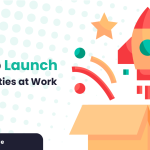.png)
So, picture this: you walk into your workplace. The atmosphere is different. It’s not just a space for work, but a buzzing hub of diverse individuals connected by more than just a company logo. It's not your usual nine-to-five scene. It's a mosaic of shared passions, mutual goals, and collective values. Welcome to the phenomenon of Communities at Work - a silent revolution shaping modern workspaces.
This trend isn't just a coincidence. It's a conscious effort by companies to adapt to the changing landscape of work. And guess what? It's working! After failing to move the needle, they’ve finally found their winning strategy: building communities at work. Let's dive into this world and explore some real-life examples that highlight why this shift is so important.
GitHub: Where Code Meets Community
Take GitHub, for instance. It's not just the world's largest code repository. GitHub is a bustling community of over 73 million developers. Beyond lines of code, GitHub is where developers gather, collaborate, learn, and push the boundaries of innovation together. It's like a massive brainstorming session where everyone's invited.
Googlegeist: Shaping Culture Through Collective Voice
Then there's Google. Even the tech giants are all in on employee communities. Googlegeist, an annual survey, isn't just a feedback form. It's a platform where employees voice their thoughts, shaping the company culture together. It's like a big virtual suggestion box where every idea counts.
Patagonia: Uniting for a Cause
But hold on, this isn't exclusive to tech bigwigs. Let's talk about Patagonia, the outdoor clothing company. Their commitment to environmental protection is a cause that brings employees, customers, and partners together. They've turned their mission into a rallying point, forming a tribe united by a love for the planet.
Remote Work Revolution: Buffer's Connected Global Community
Now, remote work? It's a whole new ball game! Companies like Buffer are nailing it. They've built a community within their globally dispersed team through online forums and virtual hangouts. Distance? Doesn't matter. They're as connected as ever, like a bunch of friends chatting over coffee, only it's all happening online.
Innovation Hub: Adobe's Kickbox and the Tribe of Innovators
And guess what else? These communities don't just foster friendships. They're hubs of creativity and innovation too. Adobe's Kickbox program is proof. It's not just about pitching ideas. It’s about building a tribe of innovators within the company. It's like a club where creativity is the secret handshake.
Freelancer Networks: Upwork and Fiverr as Virtual Co-working Spaces
And hey, freelancers aren't left out either. Upwork and Fiverr? Most see them as just marketplaces, but they're communities where freelancers find support, share experiences, and grow together. It's like a virtual co-working space where everyone's working solo but never alone.
Understanding the Shift: Insights from Research
Research from the Harvard Business Review underscores the importance of fostering workplace communities. According to their studies, employees who feel a strong sense of belonging are more engaged, leading to a whopping 56% increase in job performance. These findings highlight the tangible benefits that emerge when companies invest in building communities among their workforces.
Examples Rooted in Research
Let’s dive into some examples that echo the findings of prominent studies and publications:
- Employee Resource Groups (ERGs): Studies by McKinsey & Company emphasize the impact of ERGs on organizational culture and employee engagement. They found that companies with active ERGs report higher levels of employee satisfaction and are more successful in attracting and retaining diverse talent.
- Communities of Practice: A survey conducted by LinkedIn revealed that 68% of employees prefer to learn at work. What’s more, 94% of employees say that they would stay at a company longer if it invested in their career development. Airbnb’s internal skill-sharing programs and Schneider’s Communities of Practice program align with this sentiment, showcasing how knowledge-sharing networks positively impact employee engagement and retention.
- Cross-Departmental Collaboration: Insights from Forbes suggest that cross-departmental collaboration not only fosters a culture of innovation but also aligns with business goals. Spotify’s Squads that bring together employees from various departments align with this research-backed notion of fostering collaborative environments.
The Benefits Supported by Research
Numerous studies emphasize the benefits of workplace communities, reinforcing their profound impact on organizational success:
The Future of Work: Nurturing Interconnected Communities
So, here's the deal: the workplace is evolving, and it's not just about physical spaces anymore. It's about weaving connections, nurturing communities that transcend job titles and departments. These communities? They're not just making work better; they're shaping the future of work itself. Because, in the end, it's not about the solo cubicles. It's about the vibrant communities that fuel our collective journey forward.

.png)





